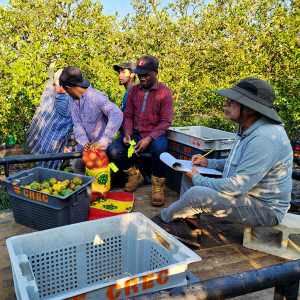A team of researchers from across UF/IFAS is making progress on updating nutrient guidelines for Florida citrus. The work is needed since current nitrogen (N) and phosphorus (P) recommendations are based on studies of healthy citrus trees. Now, the incurable Huanglongbing (HLB) disease affects 100% of Florida’s young and mature citrus trees. This research project focuses on N and P fertilizer applications for both young and mature citrus trees. Specifically, those are sweet oranges in central and southwest Florida, grapefruits in the Indian River district, and Satsuma mandarins in north Florida.
Dr. Davie Kadyampakeni is an associate professor of citrus water and nutrient management in the UF/IFAS department of soil, water, and ecosystem sciences. He leads the team in developing site-specific N and P application rates for HLB-affected citrus trees.
“Our project is evaluating five N rates and five P rates,” he explained. “By doing this site-specific, we can use each site’s soil characteristics and production practices to determine if we need to increase or decrease current recommended rates.”
Kadyampakeni and his colleagues believe the key is using fertigation and controlled release fertilizer (CRF) sources. They also are examining dry soluble fertilizers at those times of the year when it is not rainy.
“We hope citrus growers can more efficiently use N and P through these precise methods of fertilizer application,” he said. “It’s all about 5Rs: the right source in the right amount at the right time and right placement, plus the right amount of irrigation.”
Working with Growers

The research is underway at several sites in collaboration with grower cooperators and Extension agents.
“Overall, we have a total of 12 sites including 1 grapefruit grove, 4 mature Valencia orange blocks, 1 young Valencia orange block, 3 mature Hamlin orange blocks, and 3 mature mandarin blocks,” Kadyampakeni said.
He said consulting with the growers led to adjustments to the treatments for citrus fertilization. Instead of 4 treatments of 100, 150, 200, and 250 pounds per acre of N, they added a 300-pound treatment. They also adjusted the P rates from 0, 7.5, 15, 30, and 60 pounds per acre to 0, 10, 20, 40, and 80 pounds per acre.
Kadyampakeni plans to give an update on the research project’s latest results at the Florida Citrus Growers’ Institute. That is April 9th in Avon Park, Florida.
Impact on the Environment

The overall objective of the research is to evaluate the impact of N and P fertilizer on several criteria. Those are yield size distribution and the percentage of healthy vs. HLB symptomatic fruit, juice quality, fruit shelf-life, tree growth, physiology, and environmental quality. While that will benefit both the growers and consumers, there should also be a positive environmental outcome.
“If we can determine the optimal N and P rate for different growing zones in Florida based on soil characteristics,” Kadyampakeni said, “that should lead to more accurate fertilizer application.”
Another thing the scientists are studying is the leaching of nitrate and orthophosphate at the various fertilization rates and different sources and forms of fertilizer.
“We also are conducting an economic analysis of profitability estimates based on underlying cost and revenue estimates specific to varying fertilization rates and sources,” he added.
This is the second year of the project. Kadyampakeni anticipates continuing the research for a few more years to be able to publish the work in refereed journals, extension bulletins, and citrus magazines. The team will present the updated results to the UF/IFAS Plant Nutrient Oversight Committee. Those findings will result in updated recommendations on citrus best management practices.
The research is part of the UF/IFAS Nutrient Management Program, which received state funding to investigate site-specific nutrient application rates.
 1
1
